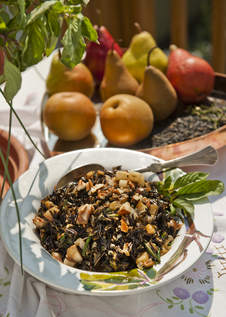This time of year, we cherish time outdoors, knowing that a sudden storm could suddenly appear, ruining our plans for just one more al fresco dinner as fall nears.
That’s when we need a recipe that will accommodate any fluctuations in weather or venue. This salad has been in my files for years. As the holidays approach, I use dried cranberries instead of fresh fruit. In winter, needing a bit of sunshine, I add diced dried apricots. But as pears are just ripening and herb gardens are lush, now is the perfect time to make it.
The grain we know as wild rice has been a food staple since prehistoric times. Marshy areas in the upper Midwest offered the native Ojibway, Menomini and Cree Indian tribes a bountiful crop of the grain they called Manomin. English explorers referred to it as Indian rice and the French thought the grain and plant resembled oats, another local crop, and called it folle avoine. The growing conditions, sunk under flooded plains for much of its growth period, resembles Asian rice paddy crops, resulting in its now common name of wild rice.
A delicious nutty flavor is just one of its benefits. Wild rice has a high protein and carbohydrate content, is very low in fat, with a nutritional quality equal or surpassing that of other cereals and a higher percentage of the amino acids in the protein than in most other cereals. Its mineral content is high in potassium and phosphorus, and provides an excellent source of the B vitamins: thiamine, riboflavin and niacin.
Areas in Minnesota, Wisconsin and Michigan offer the right growing conditions. Newer mechanized methods and hybridized grains make this a large commercial cash crop for many farmers.
In some Midwest areas, however, native American Indians are still harvesting by hand from a canoe. Either way, August is harvest time, so search out an online source such as TNT Wild Rice. Or buy a bag of the commercial product at your grocery.
There are a number of varieties of pears available locally. Bartletts in yellow or burgundy; long neck Bosc with their russet skins; or plump and rosy Comice all work beautifully. Anjou arrive later in fall, and their firm sweet nature is a good complement to the rice. Keeping the skin on adds color and a bit of nutritional value.
Make it ahead of time, as it holds for a day and travels well to a picnic site when a beautiful day beckons you to leave the dining room. The addition of a cup of chopped roast chicken or smoked turkey can easily turn it into a main dish for lunch or a light supper.

